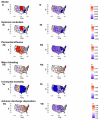Safety and Healthcare Resource Utilization in Patients Undergoing Left Atrial Appendage Closure-A Nationwide Analysis
- PMID: 37510689
- PMCID: PMC10380523
- DOI: 10.3390/jcm12144573
Safety and Healthcare Resource Utilization in Patients Undergoing Left Atrial Appendage Closure-A Nationwide Analysis
Abstract
Percutaneous left atrial appendage closure (LAAC) has emerged as a non-pharmacological alternative for stroke prevention in patients with atrial fibrillation (AF) not suitable for anticoagulation therapy. Real-world data on peri-procedural outcomes are limited. The aim of this study was to analyze outcomes of peri-procedural safety and healthcare resource utilization in 11,240 adult patients undergoing LAAC in the United States between 2016 and 2019. Primary outcomes (safety) were in-hospital ischemic stroke or systemic embolism (SE), pericardial effusion (PE), major bleeding, device embolization and mortality. Secondary outcomes (resource utilization) were adverse discharge disposition, hospital length of stay (LOS) and costs. Logistic and Poisson regression models were used to analyze outcomes by adjusting for 10 confounders. SE decreased by 97% between 2016 and 2019 [95% Confidence Interval (CI) 0-0.24] (p = 0.003), while a trend to lower numbers of other peri-procedural complications was determined. In-hospital mortality (0.14%) remained stable. Hospital LOS decreased by 17% (0.78-0.87, p < 0.001) and adverse discharge rate by 41% (95% CI 0.41-0.86, p = 0.005) between 2016 and 2019, while hospital costs did not significantly change (p = 0.2). Female patients had a higher risk of PE (OR 2.86 [95% CI 2.41-6.39]) and SE (OR 5.0 [95% CI 1.28-43.6]) while multi-morbid patients had higher risks of major bleeding (p < 0.001) and mortality (p = 0.031), longer hospital LOS (p < 0.001) and increased treatment costs (p = 0.073). Significant differences in all outcomes were observed between male and female patients across US regions. In conclusion, LAAC has become a safer and more efficient procedure. Significant sex differences existed across US regions. Careful considerations should be taken when performing LAAC in female and comorbid patients.
Keywords: atrial fibrillation; bleeding; epidemiology; left atrial appendage closure; sex difference; stroke.
Conflict of interest statement
The authors declare no conflict of interest.
Figures



References
-
- James S.L., Abate D., Abate K.H., Abay S.M., Abbafati C., Abbasi N., Abbastabar H., Abd-Allah F., Abdela J., Abdelalim A., et al. Global, Regional, and National Incidence, Prevalence, and Years Lived with Disability for 354 Diseases and Injuries for 195 Countries and Territories, 1990–2017: A Systematic Analysis for the Global Burden of Disease Study 2017. Lancet. 2018;392:1789–1858. doi: 10.1016/S0140-6736(18)32279-7. - DOI - PMC - PubMed
-
- January C.T., Wann L.S., Calkins H., Chen L.Y., Cigarroa J.E., Cleveland J.C., Ellinor P.T., Ezekowitz M.D., Field M.E., Furie K.L., et al. 2019 AHA/ACC/HRS Focused Update of the 2014 AHA/ACC/HRS Guideline for the Management of Patients With Atrial Fibrillation: A Report of the American College of Cardiology/American Heart Association Task Force on Clinical Practice Guidelines and the Heart Rhythm Society in Collaboration With the Society of Thoracic Surgeons. Circulation. 2019;140:e125–e151. doi: 10.1161/CIR.0000000000000665. - DOI - PubMed
-
- Hindricks G., Potpara T., Dagres N., Arbelo E., Bax J.J., Blomström-Lundqvist C., Boriani G., Castella M., Dan G.-A., Dilaveris P.E., et al. 2020 ESC Guidelines for the Diagnosis and Management of Atrial Fibrillation Developed in Collaboration with the European Association for Cardio-Thoracic Surgery (EACTS)The Task Force for the Diagnosis and Management of Atrial Fibrillation of the European Society of Cardiology (ESC) Developed with the Special Contribution of the European Heart Rhythm Association (EHRA) of the ESC. Eur. Heart J. 2021;42:373–498. doi: 10.1093/EURHEARTJ/EHAA612. - DOI - PubMed
-
- Virani S.S., Alonso A., Aparicio H.J., Benjamin E.J., Bittencourt M.S., Callaway C.W., Carson A.P., Chamberlain A.M., Cheng S., Delling F.N., et al. Heart Disease and Stroke Statistics-2021 Update: A Report From the American Heart Association. Circulation. 2021;143:E254–E743. doi: 10.1161/CIR.0000000000000950. - DOI - PubMed
LinkOut - more resources
Full Text Sources

